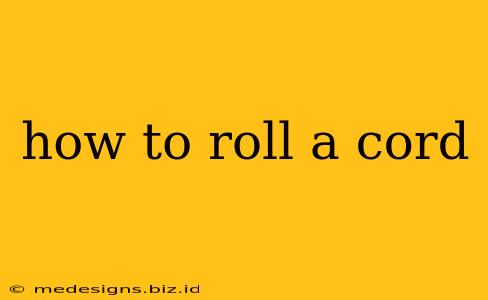Tired of tangled cords cluttering your workspace or bag? Learning how to properly roll a cord is a simple skill that can save you time, frustration, and even protect your valuable equipment. This guide will walk you through different methods for rolling various types of cords, ensuring they stay organized and tangle-free.
Why Roll Your Cords?
Before diving into the techniques, let's understand why rolling your cords is so important:
- Prevents Tangles: This is the most obvious benefit. A neatly rolled cord is less likely to knot and become a frustrating mess.
- Extends Cord Lifespan: Avoids unnecessary stress and bending on the cord's delicate inner wires, increasing its longevity.
- Improved Organization: Keeps your cords organized and easy to locate, saving you time searching for the right one.
- Professional Appearance: A neatly rolled cord simply looks more professional and polished.
Different Methods for Rolling Cords
The best method depends on the type and length of your cord. Here are some popular techniques:
The Overhand Method (for most cords)
This is a versatile method suitable for most cords, from charging cables to headphone cords.
- Start with a Loop: Hold one end of the cord and create a small loop with your fingers.
- Begin Wrapping: Start wrapping the cord around itself, keeping the wraps neat and tight. You can use your thumb to guide the cord.
- Tighten the Coil: As you wrap, periodically tighten the coil to maintain a compact roll.
- Secure the End: Once the cord is fully wrapped, tuck the loose end into the center of the coil.
The Figure-Eight Method (for longer cords)
This method is ideal for longer cords, preventing them from becoming overly bulky.
- Make a Figure-Eight: Create a figure-eight shape with the cord.
- Continue Wrapping: Wrap the remaining cord around the figure-eight, keeping the wraps tight and even.
- Secure the End: Tuck the loose end securely into the center of the figure-eight coil.
The Coil Method (for short, thick cords)
This method is best for short, thick cords that are difficult to wrap tightly.
- Loose Coil: Create a loose coil, ensuring the turns are not too tight.
- Secure the Coil: Use a rubber band or cord wrap to secure the coil and prevent it from unraveling.
Tips for Perfect Cord Rolling
- Start with a Clean Cord: Remove any debris or dirt from the cord before rolling.
- Consistent Tension: Maintain consistent tension while wrapping to create a neat and even coil.
- Use Cord Wraps: For extra organization, consider using cord wraps or ties. These are particularly useful for keeping several cords together.
- Practice Makes Perfect: Don't be discouraged if your first attempts aren't perfect. With practice, you'll become a cord-rolling pro!
Beyond the Roll: Additional Organization Tips
Once you've mastered rolling your cords, consider these extra steps to keep your cables perfectly organized:
- Label your cords: Use labels to identify each cord’s purpose, so you can quickly find the one you need.
- Use a Cord Organizer: Invest in a cord organizer box or bag to keep your rolled cords neatly stored.
By following these simple steps, you can transform a tangled mess of cords into a neat and organized collection. Say goodbye to frustration and hello to a more efficient and tidy life!
